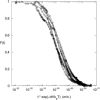DNA ejection from bacteriophage T5: analysis of the kinetics and energetics
- PMID: 15542548
- PMCID: PMC1305138
- DOI: 10.1529/biophysj.104.048785
DNA ejection from bacteriophage T5: analysis of the kinetics and energetics
Abstract
DNA ejection from bacteriophage T5 can be passively driven in vitro by the interaction with its specific host receptor. Light scattering was used to determine the physical parameters associated with this process. By studying the ejection kinetics at different temperatures, we demonstrate that an activation energy of the order of 70 k(B)T must be overcome to allow the complete DNA ejection. A complex shape of the kinetics was found whatever the temperature. This shape may be actually understood using a phenomenological model based on a multistep process. Passing from one stage to another requires the mentioned thermal activation of pressurized DNA inside the capsids. Both effects contribute to shorten or to lengthen the pause time between the different stages explaining why the T5 DNA ejection is so slow compared to other types of phage.
Figures






Similar articles
-
Forces during bacteriophage DNA packaging and ejection.Biophys J. 2005 Feb;88(2):851-66. doi: 10.1529/biophysj.104.047134. Epub 2004 Nov 19. Biophys J. 2005. PMID: 15556983 Free PMC article.
-
A kinetic analysis of DNA ejection from tailed phages revealing the prerequisite activation energy.Biophys J. 2007 Dec 1;93(11):3999-4005. doi: 10.1529/biophysj.107.111435. Epub 2007 Aug 3. Biophys J. 2007. PMID: 17675351 Free PMC article.
-
Effect of spermine and DNase on DNA release from bacteriophage T5.Eur Phys J E Soft Matter. 2005 Aug;17(4):429-34. doi: 10.1140/epje/i2005-10019-5. Epub 2005 Aug 3. Eur Phys J E Soft Matter. 2005. PMID: 16078005
-
Packaging double-helical DNA into viral capsids: structures, forces, and energetics.Biophys J. 2008 Jul;95(2):497-502. doi: 10.1529/biophysj.108.131797. Epub 2008 May 16. Biophys J. 2008. PMID: 18487310 Free PMC article. Review.
-
The bacteriophage DNA packaging motor.Annu Rev Genet. 2008;42:647-81. doi: 10.1146/annurev.genet.42.110807.091545. Annu Rev Genet. 2008. PMID: 18687036 Review.
Cited by
-
Popping the cork: mechanisms of phage genome ejection.Nat Rev Microbiol. 2013 Mar;11(3):194-204. doi: 10.1038/nrmicro2988. Epub 2013 Feb 4. Nat Rev Microbiol. 2013. PMID: 23385786 Review.
-
Temperature and pH dependence of DNA ejection from archaeal lemon-shaped virus His1.Eur Biophys J. 2016 Jul;45(5):435-42. doi: 10.1007/s00249-016-1112-7. Epub 2016 Jan 28. Eur Biophys J. 2016. PMID: 26820561
-
The effect of genome length on ejection forces in bacteriophage lambda.Virology. 2006 May 10;348(2):430-6. doi: 10.1016/j.virol.2006.01.003. Epub 2006 Feb 15. Virology. 2006. PMID: 16469346 Free PMC article.
-
Is the in vitro ejection of bacteriophage DNA quasistatic? A bulk to single virus study.Biophys J. 2010 Jul 21;99(2):447-55. doi: 10.1016/j.bpj.2010.04.048. Biophys J. 2010. PMID: 20643062 Free PMC article.
-
Temperature-dependent ejection evolution arising from active and passive effects in DNA viruses.Biophys J. 2024 Oct 1;123(19):3317-3330. doi: 10.1016/j.bpj.2024.07.037. Epub 2024 Jul 31. Biophys J. 2024. PMID: 39091028
References
-
- Abelson, J., and C. A. J. Thomas. 1966. The anatomy of the T5 bacteriophage DNA molecule. J. Mol. Biol. 18:262–291.
-
- Berne, B. J., and R. Pecora. 1976. Dynamic Light Scattering. John Wiley, New York.
-
- Boulanger, P., and L. Letellier. 1992. Ion channels are likely to be involved in the two steps of phage T5 penetration into Escherichia coli cells. J. Biol. Chem. 267:3168–3172. - PubMed
-
- Boulanger, P., M. Le Maire, M. Bonhivers, S. Dubois, M. Desmadril, and L. Letellier. 1996. Purification and structural and functional characterization of FhuA, a transporter of the Escherichia coli outer membrane. Biochemistry. 35:14216–14224. - PubMed
Publication types
MeSH terms
Substances
LinkOut - more resources
Full Text Sources

